Rogue Legacy Review: Is it Worth Playing Now?
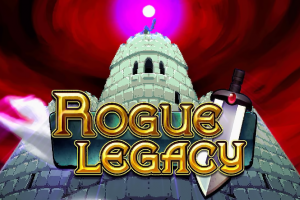
Rogue Legacy released back in 2013, and promised a rogue-like high-fantasy sidescroller with random level layouts, a perma-death mechanic with tight controls and a deep skill tree. The concept behind rogue-likes has always intrigued me, so I thought I’d pick the game up for a try.
The premise is fairly simple in that you take control of a character of a certain class (knight, mage, warrior, etc) and make your way through a castle, fighting enemies, collecting gold and defeating bosses. The twist lies in that when you die, your character permanently dies, with you then taking control of one of their offspring, who have their own unique traits and classes.
Whilst the classes are fairly standard, the character traits are what make the game unique, as they range from gameplay-altering things like vertigo (the whole game is played upside down) to the trivial (homosexuality – no effect on gameplay whatsoever).
The premise sounds addictive and engaging, but does it have the gameplay to back it up? Let’s take a look at the good, the mixed and the bad of Rogue Legacy:
The Good
Progression: Rogue Legacy’s real hook comes from its progression system. In each and every run through the castle, you’ll collect gold and runes, which you’ll be able to spend/activate for your next run after you perish. You can spend the gold on incremental gains in all your base stats like strength or health, or on new character class unlocks and various other perks. The runes are also interesting, as they give you access to special abilities like double jump, temporary flight, increased speed etc, but you have limited space for which you wish to activate, so it can be fun customising each run to suit your goal for that run.
The system amounts to a slow and steady sense of progression, incremental in nature and one that scales in line with your own skill at the game, which makes for a satisfying system and succeeds in evoking that ‘just one more run’ hook.
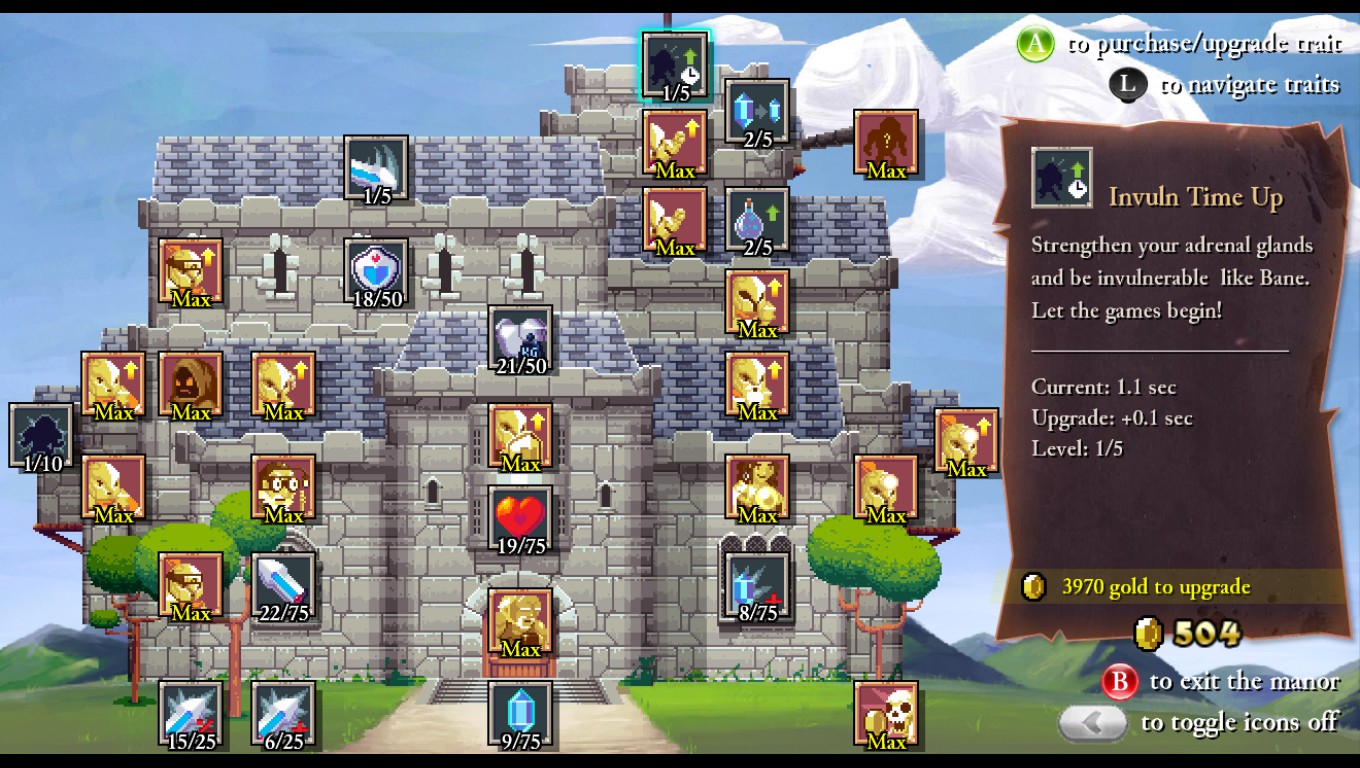
Pure gameplay: As well-designed as the progression system is, the game wouldn’t be able to hold your attention if the core gameplay and controls weren’t up to scratch. Thankfully, moving your little cartoon hero through the castle is a tight and fine-tuned experience, with the running, jumping and hacking/slashing all feeling natural and responsive.
Things do feel rather simple and limited at first, but once you unlock several of the runes and deploy things like the double jump and the dash, the depth of the mechanics shine through, and you’ll be effortlessly bobbing and weaving around enemies that initially gave you trouble.
Music: The score of the game is delightfully retro, with a several extremely catchy jingles and themes spread throughout the world, each maintaining the game’s retro-vibe whilst sounding contemporary and fresh.
Difficulty: Rogue Legacy is initially very punishing, and I found it tough to last even a few minutes in the easiest area of the castle when I started playing. This was due to both the low stats of my starting character, and my relative lack of skill as a newbie. As I pushed on however, both my ability improved and my base stats strengthened as I bought more improvements, and these two elements compounded to allow me to breeze past those areas I’d initially struggled with.
The game never gets easy though, no matter how buffed your characters get. The enemies are well designed and varied, and often fill the screen, demanding some real dexterity and reflexes to beat. The hardest zone, the dungeon, in particular is always tricky. And the bosses, which we’ll come to shortly, all pose a real challenge.
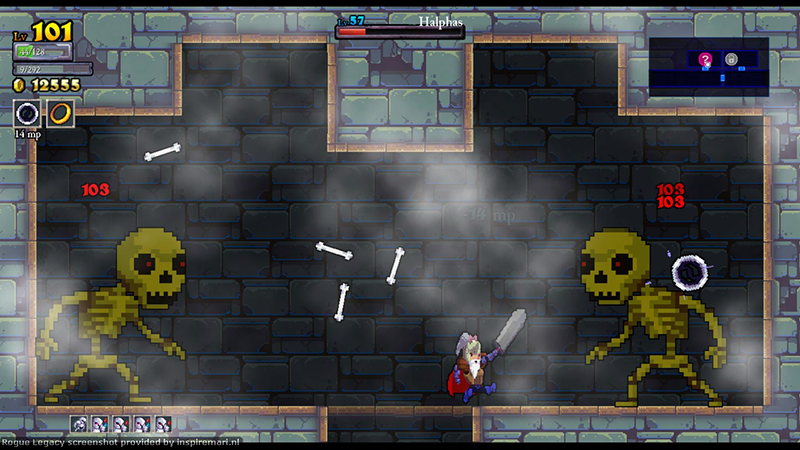
Humour: Rogue Legacy is a charming game. The sprite designs are cute and full of character, and the writing is witty and full of dry humour. The descriptions of your character traits are funny, and the 27 diary entries scattered throughout the castle documenting a previous adventurer’s journey through the castle is a funny tale of discovery and horrific realisation.
Bosses: There are several main bosses in the game, one for each of the four areas, and a couple at the end that make up the final battle. Each one is unique in their design and represents a different type of challenge, and took a fair few attempts in order to beat them. All the main bosses are well done and satisfying to defeat, and once a boss is beaten, it stays beaten, meaning you don’t have to defeat them again. Instead, a ‘remixed’ version of the boss appears in their place, which represent the hardest challenges in the game. They’re really tough.
A neat feature related to the bosses comes in the form of the Architect. Because the castle layout resets whenever you die, it can be a real challenge to track a boss down again that you want to topple – that is, unless you make use of the Architect, who saves the previous castle layout for you, but for the cost of most of your gold!
There is also an array of mini-bosses that you’ll meet throughout the castle, that mainly manifest as giant versions of regular enemies. They can be tricky, but reward you with runes or mountains of gold.
The Mixed
Remix bosses: The remixed-versions of the bosses that appear after you defeat a boss are tougher than their respective vanilla versions, and by an order of magnitude or two. They’re fiendishly difficult, some requiring ridiculous dexterity, luck and reflexes to defeat. You’re transformed into a pre-determined hero whenever you fight them, ofter with debilitating traits, which just serves to compound the difficulty. Mercifully, you’re able to attempt each boss as many times as you like whenever you encounter them, but I felt they were just a touch too tough to be considered enjoyable. But maybe I’m just not good enough!
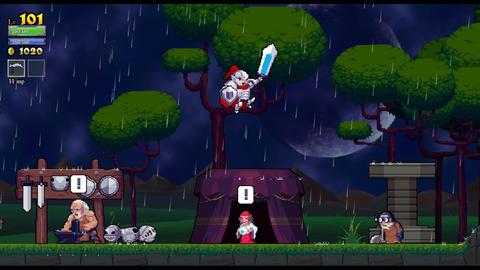
Graphics: The pixel-art in the game is charming and certainly does its job, and some of the character designs are excellent, but there’s sadly some inconsistency in this area. For every detailed mace-wielding knight there’s a poorly rendered wolf or horse. It’s a shame, as a little more care in this area would’ve gone a long way.
Not enough traits: The traits can be either funny, useful or debilitating, and sometimes a combination of all three. But there just aren’t enough of them, and most of them don’t have enough of an impact to bother with. I found myself looking for the type of character rather than the character traits when picking my next hero, and ended up just ignoring the traits completely. Some more traits that have a fundamental impact on the game would have been more interesting, and made me pay attention to the traits more.
The Bad
Magic: Every character has two main types of attack, melee and magic. The magic attacks are usable via a mana bar, which depletes the more you use it. Sadly, most of the magic attacks aren’t as helpful as the sword, and the mana bar depletes rather quickly, so this leads to an imbalance that causes you to avoid picking the magic-type characters and lean towards the warrior or barbarian types. It’s a shame, because a lot of the magic attacks are pretty inventive, like conjuring a giant sword that hovers in the air and slices through anything that touches it, and balls of fire that rotate around your character. In a follow-up, more weight should be given to the magic traits.
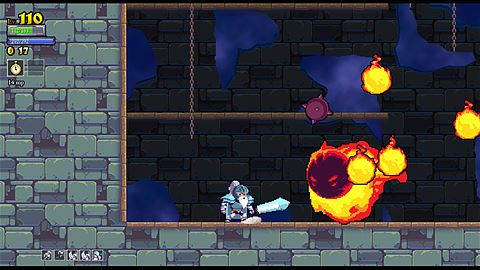
Not enough variety: As charming as the enemy design is, it does feel as though the Rogue Legacy could’ve done with a little more variety. Several of the types are just re-coloured or re-sized versions of earlier enemies, and things do get rather same-y after a while.
Vertigo: As much as I appreciated the humour of flipping the game upside-down for a character with vertigo, the game is just so difficult to play in that state that I just ended up avoiding any characters with the trait altogether. A shame, but there we are!
Overall
Overall, Rogue Legacy is a charming and addictive rogue-like sidescroller. The controls are simple and tight, but take time to master, and the gameplay loop of incrementally improving your characters’ skills is addictive and rewarding. I’d recommend Rogue Legacy to anyone interested in the rogue-like genre, and certainly to anyone already with a keen interest in it.
It’s available here from Amazon.
Overall: 8/10.